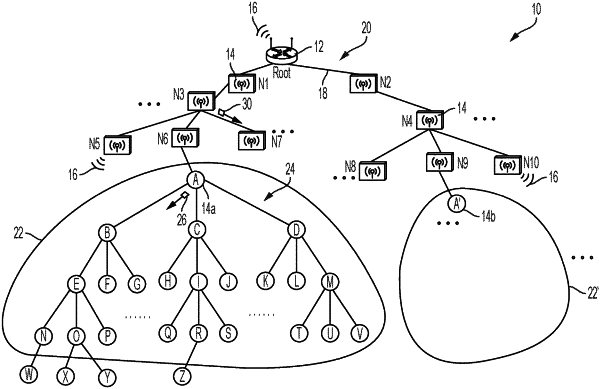| CPC H04L 12/18 (2013.01) [H04L 45/16 (2013.01); H04L 49/201 (2013.01); H04L 65/611 (2022.05)] | 8 Claims |

|
1. A method comprising:
generating, by a network device, a destination oriented directed acyclic graph (DODAG) that is rooted by the network device, the generating of the DODAG based on outputting an instruction implementing multicast communication in the DODAG; and
multicasting, by the network device, a targeted packet that is destined for at least one targeted member device of the DODAG, the targeted packet causing sequential unicast communications in the DODAG,
wherein the targeted packet causes a router device in the DODAG to establish a unicast route for reaching the destination device within a prescribed limited number of hops, and
wherein the targeted packet is a unicast packet specifying a destination address encapsulated within a multicast packet specifying a multicast address, the at least one targeted member device operating as a destination device and processing the unicast packet in response to detecting the destination address associated with the destination device.
|
|
4. An apparatus implemented as a physical machine, the apparatus comprising:
non-transitory machine readable media configured for storing executable machine readable code, wherein the apparatus is implemented as network device;
a device interface circuit; and
a processor circuit configured for executing the machine readable code, and when executing the machine readable code operable for:
generating a destination oriented directed acyclic graph (DODAG) that is rooted by the network device, the generating of the DODAG based on outputting an instruction implementing multicast communication in the DODAG, and
multicasting a targeted packet that is destined for at least one targeted member device of the DODAG, the targeted packet causing sequential unicast communications in the DODAG,
wherein the targeted packet causes a router device in the DODAG to establish a unicast route for reaching the destination device within a prescribed limited number of hops, and
wherein the targeted packet is a unicast packet specifying a destination address encapsulated within a multicast packet specifying a multicast address, the at least one targeted member device operating as a destination device and processing the unicast packet in response to detecting the destination address associated with the destination device.
|
|
7. One or more non-transitory tangible media encoded with logic for execution by a machine and when executed by the machine operable for:
generating, by the machine implemented as a network device, a destination oriented directed acyclic graph (DODAG) that is rooted by the network device, the generating of the DODAG based on outputting an instruction implementing multicast communication in the DODAG; and
multicasting a targeted packet that is destined for at least one targeted member device of the DODAG, the targeted packet causing sequential unicast communications in the DODAG,
wherein the targeted packet causes a router device in the DODAG to establish a unicast route for reaching the destination device within a prescribed limited number of hops, and
wherein the targeted packet is a unicast packet specifying a destination address encapsulated within a multicast packet specifying a multicast address, the at least one targeted member device operating as a destination device and processing the unicast packet in response to detecting the destination address associated with the destination device.
|